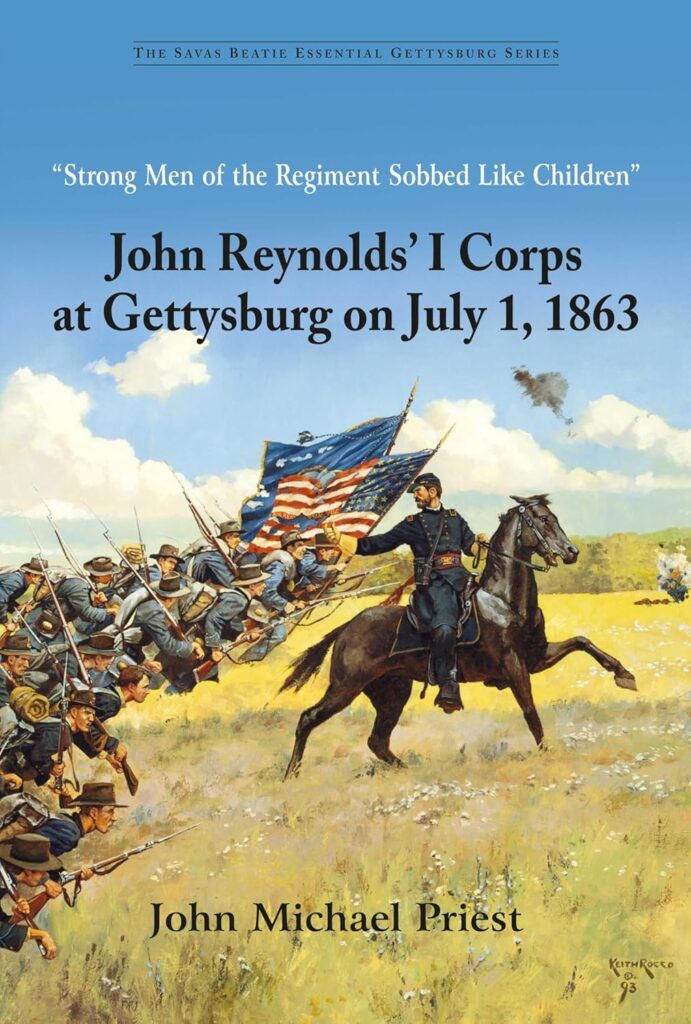By John Michael Priest.
El Dorado Hills, CA: Savas Beatie, 2024.
ISBN 161-1-21689-3. Illustrations. Maps. Notes. Bibliography. Index.
Pp. 448. $37.50.
There have been many books written about the Battle of Gettysburg, with much attention focused on 2 and 3 July 1863. For many scholars, the fighting on 1 July has been treated as an afterthought. Thanks to historians like John Michael Priest, many more books are now available addressing the Battle of Gettysburg’s first day. Priest has provided the Civil War community with a new standard of excellence in scholarship.
After a delaying action by Brigadier General John Buford’s cavalry, Reynold’s infantry and artillery began arriving on the morning of 1 July to stem the tide of Confederate troops advancing towards Gettysburg. Heavy fighting, led by the Union’s veteran Iron Brigade, caused both the Army of the Potomac and the Army of Northern Virginia to bring up reinforcements. Students of the battle of Gettysburg know well the sacrifice of I Corps.
When the fighting ended on 1 July, I Corps had lost much of its fighting strength and was in full retreat, which took it to Cemetery Hill. Its heroic fight, together with XI Corps north of town, bought crucial time for Major General George G. Meade to arrive on the battlefield with the rest of the Army of the Potomac and ultimately defeat Robert E. Lee and his Army of Northern Virginia. I Corps fought against overwhelming odds in preventing a complete disaster. At the end of the first day of the battle, I Corps lost 2,361 men; about forty percent of the casualties suffered were missing or captured (p. 374). Among the dead was Reynolds, shot from his horse by a Rebel sharpshooter. Priest does a good job describing the role of the terrain, which will help students understand the successes and failures of the different units fighting on the first day with and against I Corps.
Priest’s book is different than other books on the Battle of Gettysburg. He focuses on primary sources that originate mainly from the enlisted men and junior officers. Priest emphasizes their opinions and many of their concerns about the fighting and officer decisions. He also asserts that there is no substitute for listening to the voices of those who were at Gettysburg on 1 July, soldiers and civilians alike. As Lieutenant Walter Chester wrote in a letter to the Buffalo Courier, “Many brave, strong men of the regiment sobbed like children thinking of the seemingly utter wreck of our noble corps” (p. 374).
Priest presents to students and scholars alike a readable, unbiased, illuminating, fast-moving, and well-written narrative that should be used in any future academic research. This work contains nineteen original maps, which mostly represent fifteen-minute intervals in the fighting; numerous photos of individual participants; an Order of Battle; and primary source information from forgotten memoirs, diaries, letters, newspapers, books, casualty lists, and articles to write this excellent volume. One thing that was unusual but positive in the account was the detailed and entire story of the citizen-soldier John Burns, who fought and was injured during the battle.
Readers who count themselves among the many Battle of Gettysburg aficionados will find this study of great interest. “Strong Men of the Regiment Sobbed Like Children” is an excellent book and will be of interest to those with an interest not just in Gettysburg itself, but also unit history and the Civil War in the Eastern Theater.
David Marshall
Miami, Florida
